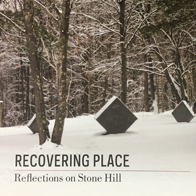
July 4–October 10, 2016
rifle
John Barney Wright’s Sharps rifle
Sharps Rifle Manufacturing Company
Hartford, Connecticut, mid–late nineteenth century
Lent by the Berkshire Historical Society
TRANSCRIPT:
It has heft—almost ten pounds—and the length you’d expect from a sharpshooter’s rifle: just over four feet from butt plate to muzzle tip, its octagonal barrel extending thirty-one inches alone. Line up the Vernier peep sight—a dime-sized black disc with a pinhole on a folding mount—with the hooded front sight, complete with a level, and you understand the gun’s reputation for long range accuracy. To qualify for their units, Civil War sharpshooters had to be able to fire ten rounds into a three-inch hole at two hundred yards. Buffaloes could be knocked to their knees at five hundred to one thousand yards—the power provided by a .44 caliber cartridge, and the design by the renowned gun maker Christian Sharps.
This was John Barney Wright’s gun, modified for bear hunting. Barney lived on Henderson Road. Most bears he caught in traps and clubbed to death, but around forty of the 100 that he killed were likely killed with this rifle. In 1874, when he had been at it for thirty years, he fetched $15 for the hide, a $15 bounty from the state, and $20 for the meat for each bear. He had worked his father’s farm until at the age of nineteen he decided that the wilds were his real home. Although married, he tramped those woods alone for the next fifty years, an anachronism even then—unfriendly and solitary and impressing all until his death at ninety-three, with his whalebone constitution and teeth as sound as ivory. One late eyewitness account described him as “an eerie-looking cuss” who appeared “mean as hell.” Those bears staring down the business end of his rifle would have had to agree.
Photo: Barry Goldstein
Jim Shepard is the author of seven novels, including most recently The Book of Aron, which won the Sophie Brody Medal for Achievement in Jewish Literature from the American Library Association and the PEN/New England Award for fiction, and four story collections, including Like You’d Understand, Anyway, which was a finalist for the National Book Award and won The Story Prize. Five of his short stories have been chosen for the Best American Short Stories, two for the PEN/O. Henry Prize Stories, and one for a Pushcart Prize. He teaches at Williams College.
Recovering Place: Reflecting on Stone Hill
By Mark C. Taylor
An illustrated book chronicling the land art and sculptures created by Mark C. Taylor at his home in the Berkshire hills, echoing themes found in the exhibition. Supported in part by Herbert A. Allen, Jr. and the Clark Art Institute and published by Columbia University Press. Call the Museum Store at 413 458 0520 to order.


